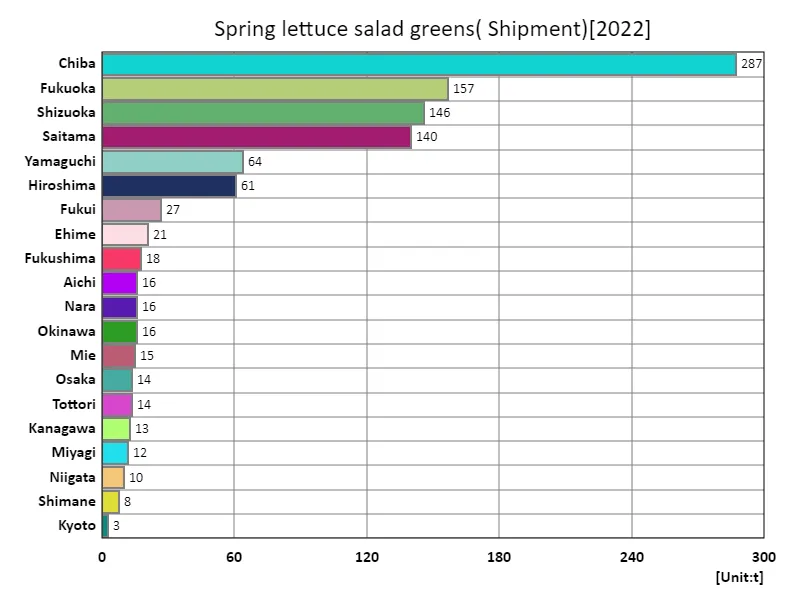- Abstract
- Spring lettuce harvest volume of salad greens (main data).
- Spring lettuce harvest volume of salad greens (by prefecture).
- The area planted with spring lettuce, salad greens (main data).
- The area planted with spring lettuce (by prefecture).
- The amount of spring lettuce shipped is salad greens.
- Reference
Abstract
Data on leafy vegetables in Japanese agriculture, particularly spring lettuce (salad greens), shows relatively stable harvest volumes for 2022 of up to 1.19kt per prefecture. On the other hand, the maximum cultivated area is 70 ha, which suggests that it is cultivated over a relatively wide area. In terms of shipping volume, Chiba recorded the highest figure of 287 tons, indicating that the product is actually being supplied to the market. These data show that spring lettuce (salad greens) is cultivated over a wide area, with relatively stable harvests in each prefecture, and that it is also shipped according to demand.
Spring lettuce harvest volume of salad greens (main data).
Looking at data from 1989 to 2022, the spring lettuce (salad greens) harvest volume in Japanese agriculture has fluctuated. At its peak in 1992, the national harvest yield was 2.53kt, but has been declining since then. Current harvest yields are at 47% of their peak, half of previous peaks. This trend indicates that the demand for and cultivation conditions for spring lettuce (salad greens) are changing. Possible reasons for the decline include changes in demand for other vegetables and food ingredients and advances in agricultural technology. Climate change and market competition may also be playing a role. Given these trends, cultivation and harvest volumes of spring lettuce (salad greens) may fluctuate in the future depending on changes in demand and market conditions.


The maximum is 2.53kt[1992] of Japan, and the current value is about 47%
Spring lettuce harvest volume of salad greens (by prefecture).
Looking at the latest data for 2022 regarding the yield of leafy vegetables in Japanese agriculture, Chiba Prefecture recorded the highest overall yield of 301 tons, which is currently the highest value. This is the highest yield by region, suggesting that Chiba Prefecture has a leadership position in leafy vegetable production. This trend reflects the fact that Chiba Prefecture has excellent agricultural techniques and efficient land use, providing an environment suitable for the cultivation of leafy vegetable crops. The results also show that Chiba Prefecture has achieved particularly excellent harvest yields compared to other prefectures. This may be due to differences in climate and soil conditions from region to region, as well as the influence of agricultural policies. Going forward, we hope to see efforts to increase leafy vegetable yields by taking advantage of the unique characteristics and productivity of each region, including Chiba Prefecture.


The maximum is 301t of Chiba, the average is 39.6t, and the total is 1.15kt
The area planted with spring lettuce, salad greens (main data).
Looking at data on the area planted with spring lettuce (salad greens) in Japanese agriculture, there is fluctuation between 1989 and 2022. The peak area of cultivation was in 1992, when 132 hectares were recorded across all prefectures. However, the trend has been downward since then, and the current cultivated area in prefectures is only 53% of the peak. Possible reasons for this decline include changes in food culture, changes in market demand, and increased productivity due to advances in agricultural technology. Regional factors such as urbanization and the decline of agricultural land may also be contributing factors. This trend indicates that demand for and production of spring lettuce (salad greens) is decreasing compared to the past. Going forward, it will be necessary to respond to changes in demand and consumer preferences while striving to achieve a sustainable recovery in production through efficient cultivation methods and the use of local resources.


The maximum is 132ha[1992] of Japan, and the current value is about 53%
The area planted with spring lettuce (by prefecture).
According to data from 2022, the area of land planted with leafy vegetables in Japanese agriculture varies by prefecture, with the largest overall being Chiba Prefecture at 16 hectares, which is the current largest value. This suggests that Chiba Prefecture has a leadership role in the cultivation of leafy vegetables. The reasons why Chiba Prefecture leads other regions include the region’s climatic conditions, suitable soil, and advances in agricultural technology. It is also possible that Chiba Prefecture is actively engaged in the production of leafy vegetables. However, cultivation of leafy vegetable crops may vary from region to region, as the area under cultivation in other regions is relatively small. Additionally, changes in agricultural policies and market demand are also considered as factors that affect the area under cultivation. In the future, it will be important to make use of the local resources and characteristics of each region while working to promote efficient cultivation methods and sustainable agriculture.


The maximum is 16ha of Chiba, the average is 2.38ha, and the total is 69ha
The amount of spring lettuce shipped is salad greens.
According to data from 2022, the largest overall shipment volume of spring lettuce (salad greens) in Japanese agriculture was in Chiba Prefecture at 287 tons, with an average of 36.8 tons, and a total of 1.07 kt. A notable feature of these figures is that Chiba Prefecture had the highest shipping volume, indicating that it has a certain leadership position in the production of leafy stem vegetables. In addition, the average shipping volume was 36.8 tons, indicating that demand for lettuce is relatively stable. These figures indicate that spring lettuce (salad greens) is in demand as a common food ingredient. Furthermore, the total shipment figure of 1.07kt suggests that leafy vegetable production is remaining at a constant level. However, rather than a few regions or producers dominating the rest in terms of large-scale production, there appears to be a relatively decentralized production system. This may reflect differences in regional climatic conditions, agricultural techniques and market demand. In the future, in addition to responding to changes in demand and promoting sustainable agriculture, it will be necessary to build more efficient production systems through regional collaboration and information sharing.


The maximum is 287t of Chiba, the average is 36.8t, and the total is 1.07kt



Comments